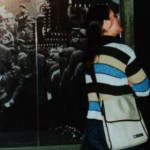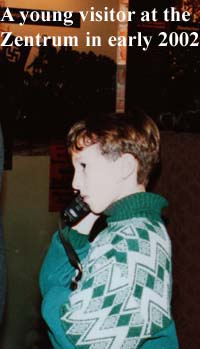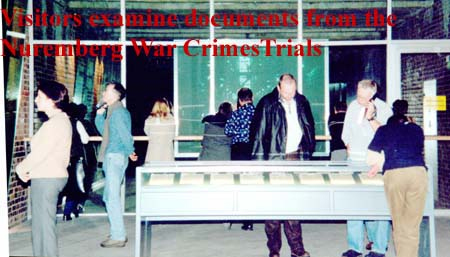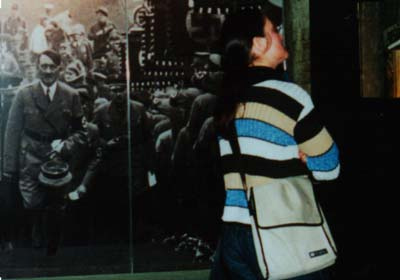
A woman examines an exhibit at the Nurember Dokumentationzentrum located in the never-finished Nazi Party Kongresshalle in Nuremberg
A dictator can extend his reach across the world to inflict great harm on his perceived enemies, but before World War II he required an army with trained multitudes, transportation and, most importantly, a large network of loyal supporters. Those requirements changed in the 1920s with mass and electronic communication; World War II with its millions of dead was the result.
Albert Speer, a penitent former Nazi minister who pled guilty at the Nuremberg Trials, summed up this new danger in his 1969 autobiography, Inside the Third Reich: “Dictatorships of the past needed assistants of high quality in the lower ranks of leadership also, men who could think and act independently. The authoritarian system in the age of technology can do without such men. Telephone, teletype and radio made it possible to transmit the commands of the highest levels directly to the lowest organs where because of their high authority they were executed uncritically.”
Although this lesson is understood by professors and politicians, young Germans, speaking for all of us, still ask, ‘how could the people I see every day participate in the terrible persecutions of the Nazi era?’ To answer this question, in November 2001, the City of Nuremberg opened the Documentation Center for the Nazi Party Rally Grounds in one wing of the old, unfinished Nazi Kongresshalle.
This permanent exhibition, Fascination and Terror, documents how the Nazis used mass communication, censorship, nationalism and fear to dominate eighty million people. It also explores the role of Nuremberg in the rise of National Socialism and in World War II, its destruction at the end of the war and the Nuremberg Trials where top Nazis were tried and executed for crimes against humanity.
The Dokumentationszentrum
Knowing that people she sees daily may have associated with the Nazis is a little frightening for Svenja Schmidbauer, 16, a native of Nuremberg. “I can’t believe that they were in favor of Hitler, worked for him or something. They are normal people, like everybody else, your own grand- or great-grand parents. That shows you that everybody – normal people, old people, even children- everybody allowed this to happen or even supported the Nazis,” she said.
Schmidbauer went to the Documentation Center for the Nazi Party Rally Grounds in February with her class and a group of visiting British students. She said her classmates looked forward to the visit because it is difficult for young people to understand how everyday Germans could allow-and participate in–horrific abuses of Jews and others. She first read books about National Socialism at age 10 or 12, and the topic was covered in school lessons.
At 14, Schmidbauer went to a small, temporary version of Fascination and Terror with her class, but even this exposure to the era didn’t prepare her for the documentation center. “I knew something about the Nazis before I went there, but this was a new experience. When I watched the film, I really experienced the atmosphere when Hitler made a speech,” she said. “It can make you really afraid when you hear Hitler’s voice or the look on people’s faces in the movie. You feel like Hitler is talking directly to you! Suddenly I felt guilty. Not because I like his ideas or something–of course not– but you listen to him and see all the other people cheering.
“I think it is very “beängstigend” (scary) when you see that one person can make so many people forget all their human feelings. It is hard to understand how they were able to do such terrible things! What did Hitler do to bring that out in people? It seems like all of Germany threw away its brain. I get really frightened when I see that it is possible to make people so cruel,” Svenja said.
Sven Mueller, 30, also a native of Nuremberg and a salesman for Ernst & Young, visited the center in January. Mueller’s interest in World War II started at home: his grandfather was drafted late in the war, at age 16, and served as a prison laborer in a French-operated coal mine for two years after the war. “He still has nightmares,” said Mueller. After going through the exhibit, Mueller mused on the value of the center.
Due to the natural cycle of time, “there is (now) a generation that has no relationship to the Nazi period, as previous generations have had, ” he said. Plus, since German students are barraged with collective national guilt throughout their scholastic careers, “there is a danger that young people will get fed up with hearing about Nazi Germany. This exhibit is very neutral, so everyone can judge the facts as presented,” he added.
The exhibit appealed to Schmidbauer in a different way. “I think it’s very interesting, especially for younger people because you don’t have to read all the information as in a normal museum. You can listen to the audio, and there are films and speakers. For young people it is better than a normal museum,” she said.
The Driving Force
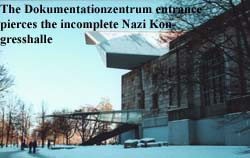
The entrance to the Dokumentationzentrum was meant to pierce the unfinished wall of the Kongresshalle to destroy its integrity, spearing the heart of the massive building
Although it had long been agreed that some proper exhibit on Nuremberg’s role in the rise of National Socialism was required, one man, Dr. Franz Sonnenberger, had the desire and position to bring the project to fruition. “He was the driving force,” said Hans Christian Taeubrich, director of the Documentation Center. In 1994 Sonnenberger had been appointed director-general of the Museums of the City of Nuremberg, a collection of 10 museums including the German National Museum and Albrecht Duerer House.
He immediately began working to establish a permanent, year-round exhibition on the Nazi Party Rally Grounds and Nuremberg’s role in the rise of the Nazi party. Nuremberg museum officials had sought funding, without success, from the State of Bavaria and the German federal government for a permanent exhibit along the lines of Fascination and Terror. Events conspired to resolve the issue.
The city’s 950th anniversary, celebrated in 2000, generated interest in how the city would deal with its 12 years under National Socialism, creating both impetus and a deadline for action, said Taeubrich. Sonnenberger managed to set up two advisory boards, one of professors of modern history and the other of influential politicians, and this was the breakthrough that put the project on a firm footing, Taeubrich said.
By the end of 1997 the project was taking shape. In the end, the City of Nuremberg, the Free State of Bavaria and the Federal Republic of Germany each contributed one-third of the estimated $9 million required. When the project ran almost $2 million over budget, the City of Nuremberg made up the deficit and now maintains the center without help from either state or federal governments. Building the Center From the beginning, museum officials were determined to avoid the center becoming a focal point for those who would glorify the Nazi party.
With that proviso, eight architects of varying ages from Austria, Switzerland, Germany and Nuremberg itself were invited to submit designs. Winning architect Guenther Domenig designed a clear glass entryway that pierces one corner of the wing housing the center. The shaft both destroys the symmetry of the classical building and brings sunlight to its murky interior. The design is a deliberate effort to open Nuremberg’s connection to Nazism for public scrutiny and debate.
Due to various delays, construction didn’t begin until January 2000, so the center was not ready for the anniversary celebrations, but since then visitors have thronged to the exhibition. “We expected some 100,000 visitors per year and, in the seven-and-a-half months since opening, have had 145,000 visitors…and about forty percent of the visitors were school children,” said Taeubrich.
The Exhibit
Upon entering the exhibit, visitors view a 35-minute film encapsulating the pageantry and pathos of the Nazi regime, focusing on the role Nuremberg played. Familiar file footage of the rallies and clips from documentaries, including the famous propaganda film, Triumph of the Will, draw viewers back in time when thousands of goose-stepping Wehrmacht soldiers and rapt civilians, arms thrust out, paid homage to Nazi leaders in the familiar streets of Nuremberg.
The spell is broken as those who lived through it tell what it was like to watch their peaceful old city change to a swastika-bannered showcase for Hitler’s racial oppression and war machinery. Entering the display area, visitors are faced with a life-sized photo of German soldiers firing an artillery piece during one of the Nuremberg rallies, the familiar Zeppelin Tribune in the background.
Inset is a large photo of well-dressed civilians in the Tribune grandstand, many of them women, faces lit with excitement, arms outthrust in the Nazi salute. The message is clear: this happened in your city and these were your neighbors. The center has some innovative displays, including tin soldiers in a diorama under glass, set in the floor, another deliberate effort to place the Nazis underfoot, deride their philosophy and deter those who would glorify the regime.
In another room an original poster shows the 40 or so badges concentration camp inmates outside the “Aryan” definition had to wear, with variations for violating racial laws. As one progresses through the shadowy brick rooms, a chilling recording of Hitler exhorting his listeners echoes through the chambers. Further along, visitors are confronted with a determined-looking Fuehrer marching up to them in a life-size photo.
One of the most plebian artifacts makes a powerful display. A Nuremberg resident took scores of photos at the rallies and of construction on the site and his album is under glass in the center. Each photo has been scanned and can be viewed via a touch-sensitive display with captions in three languages. Many displays are devoted to showing the darkest side of the National Socialist party.
One display is a huge photo of a dead slave laborer sprawled on a rock pile in one of the quarries supplying granite for the monuments. An adjacent video features an interview with a former slave laborer walking through a defunct quarry while relating the horrible conditions the workers suffered under while being worked to death. The final room of the exhibit is devoted to the Nuremberg Trials.
Ostensibly, Nuremberg was chosen for the trials because it had one of the few intact jails connected to an intact courthouse in Germany, but some higher purpose was served when the leaders of Nazi Germany were tried, sentenced to death and executed within a few miles of the monuments they had built to last a millennium. The last display shows the physical humiliation of Nuremberg and National Socialism: a 12 foot-long by 8-foot-high aerial photo of the blackened ruins of bomb-devastated Nuremberg, inset with a photo of jubilant Allied soldiers waving flags, guns and swords atop the Luitpold Tribune on the rally grounds.
The Forum
The center was specifically designed to help inform younger people about the Rally Grounds and Nazism in general. “That is why we put high importance on the second component of the center, which is the educational forum, two modern rooms on top of the Kongresshalle wing, above the exhibition,” said Taeubrich. Documentation Center officials carefully planned an educational program to complement the exhibit and answer questions children might have.
Teachers can request a hosted discussion on the mechanisms of propaganda, human rights, or a score of other topics during class visits: more than 380 sessions have been booked since late November. Typically, students are given worksheets and allowed to go through the exhibits at their own pace, said Gesa Buechert, a historian with the Arts and Culture Education Center, affiliated with the City of Nuremberg Museums.
Buechert leads group discussions with students after they have seen the exhibits. “We talk with them about different themes, answer their questions and show films and pictures to broaden their view of National Socialist times and how propaganda was used to influence the population,” said Buechert. Her group tries to show visitors how economic hardship and propaganda created an atmosphere where civil rights abuses could flourish.
“After visiting the documentation center and talking about it, they understand a little bit about the propaganda campaigns and tricks the National Socialists used to influence people,” Buechert said. Following their visit to the exhibit area, Schmidbauer’s class, along with a group of visiting English students, met in the forum to talk about racism. Germany has about two million ethnic Turks, many of who were allowed into Germany as Guest Workers.
Guest Workers and family members are not always entitled to German citizenship, though they can collect some social benefits. This political limbo induces conflicting loyalties in workers and resentment in some Germans. “We’ve talked about minorities in Germany and there are students who don’t like minorities,” said Schmidbauer. “We talked about how that feeling develops, and why those particular students think they don’t want to have Turks in Germany.”
Schmidbauer said she didn’t think the visit to the center had changed anyone’s opinions “but they thought about it,” she said. Their speaker used examples from the class to show how everyone, in some way, has racial prejudices of one sort or another, had told a racist joke, or listened to one, and how these were the first step towards intolerance.
“I think some people were shocked as they recognized the examples could have been them,” Schmidbauer said. The Documentation Center for the Nazi Party Rally Grounds is unique in that it has been designed to enlighten young people as to how the excesses of National Socialism could take root in a civilized people.
“Nobody understands how it could go that far,” said the 16-year-old Schmidbauer. “I think that this topic of the Nazis is something that almost every person in Germany thinks about.” Schmidbauer thinks Europeans, at least, have learned their lesson and another Holocaust is unlikely, “I don’t think it could happen again on that scale…but maybe the people thought the same before World War II. I think if somebody had told them what would happen, nobody would have believed it. Perhaps it’s the same nowadays,” she said.
Latest News
- Teachers bring new methodologies, in-depth studies and sunshine to classrooms through Vegesna grants
- Feature: Entrepreneurship and Beyond: Skills learned in incubator classes guide startup development and pay off in life
- Harker Communication Office Wins Prestigious Awards
- Harker Quarterly Wins CASE Award of Excellence
- Harker in the News

